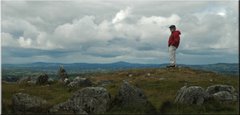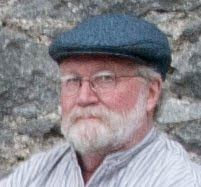Day 19 of 35: Sunday, August 22, 2010
This was a day of mixed activities in and around Birr, including getting ready for our first extended foray since Diane's accident. We would head for the peninsulas at the southwest of the Island the following day, and she spent most of the day in the Bothy preparing for that, staying off her ankle as much as possible.
My day began with another morning trip to the archives, this time to take pictures of some of the images in the 4th Earl’s photo album from his trip to North America in 1891, including his visit to Lick Observatory and Felton. The album is not part of the archives, and Lady Rosse was very kind to bring it to me from the family's private materials.
 The road to Lick Observatory, circa 1891. I have driven that road many, many times over the past four decades, and recognized that curve immediately.
The road to Lick Observatory, circa 1891. I have driven that road many, many times over the past four decades, and recognized that curve immediately.
 This stand of redwoods is in what is now Henry Cowell State Park, California, very near our home.
This stand of redwoods is in what is now Henry Cowell State Park, California, very near our home.
The door I now usually used to and from the Archives is one on the castle’s lowest level marked “Castle Flat,” which I suppose used to be the servants’ entrance. Below is Castle Cat (as opposed to Bothy Cat), a one-eyed sweetie, about the same size and cobby shape as the Bothy Cat, who is clearly fed at that door.
 Her bowls have been empty at each of my visits, and she has let me know about it in no uncertain terms. Also notice the iron boot-scraper – varieties of such scrapers are built into the stonework by every door to the castle that we’ve seen, including the formal, main entrance.
Her bowls have been empty at each of my visits, and she has let me know about it in no uncertain terms. Also notice the iron boot-scraper – varieties of such scrapers are built into the stonework by every door to the castle that we’ve seen, including the formal, main entrance.
 This photo was taken as I was leaving the castle after my morning in the archives; it is a view toward the great telescope from near the castle's front door, off limits to general parkland visitors. From here, it's easy to see why the telescope's east support wall is much more ornate than the bare, functional west one: the east wall is the one that can be seen from the house!
This photo was taken as I was leaving the castle after my morning in the archives; it is a view toward the great telescope from near the castle's front door, off limits to general parkland visitors. From here, it's easy to see why the telescope's east support wall is much more ornate than the bare, functional west one: the east wall is the one that can be seen from the house!
In the afternoon I took a short foray out of town to the north, toward the Shannon and the ancient monastic city of Clonmacnoise (which we had visited four years ago.) I was looking for a hamlet that Ronnie Peterson had asked me to take a photo of, a place called Clonfinlough, in which a friend of hers spent her childhood. I had located a place called “Clonfanlough” on Google Earth before we left for Ireland, and its dot was just to the east of Clonmacnoise, but no map was terribly helpful in guiding me to a precise spot. After some pleasant exploration on back roads to the south of the River Shannon, I found a loose string of mostly new homes and a new-looking church on an unnumbered road off the Clonmacnoise road… and an intriguing sign:

The sign points to a long, uphill path, very well-maintained and closely bounded by tall hedgerows, to this gate:

Beyond the gate, lying in an ordinary pasture, is the Clonfinlough stone. The stone is roughly square, about six feet on a side. What I did not know until later that day (when I stumbled across an explanatory sign in a village miles away – as accidental a find as the stone itself, but I wish I had the accidents in the other order) is that the stone is covered with what are believed to be Neolithic engravings (including the carved shod-foot print at right), perhaps depicting a prehistoric battle. Had I known that at the time, I would have paid more photographic attention to the other marks, but there is no explanation at the site of what the stone’s significance is.
It was clear, however, that the stone's location atop the long esker on the Shannon's south side provides a magnificent view to the South:

That evening, we attended an organ recital at St. Brendan’s church at the other end of Oxmantown Mall from the Demesne’s main gates. Lord Rosse had told us of the event when we visited with him and Lady Rosse on Friday evening, and urged us to attend. It was well worth our time, both for the music and for the experience of the church’s interior (and for watching the interactions of its small congregation.) After the recital, Lord Rosse pointed out the memorial plaques on the walls to the prior Earls of Rosse, including the largest one, behind the balcony, looking down on the entire congregation, to the Third Earl (the “Telescope Earl”). He took me upstairs to the balcony, where I could see the plaque more clearly and read its inscription, which is a beautiful one that expresses a scientist’s awe at the universe around him. I wished I had my camera there, but I hadn't thought it would be appropriate. Lord Rosse urged me to bring the camera to the church sometime after our venture to the southwest, and I did so the following Sunday.
 St. Brendan's Church of Ireland, Birr, in an early February rain, 2011. Photograph by and © Stephen Callaghan, all rights reserved.
St. Brendan's Church of Ireland, Birr, in an early February rain, 2011. Photograph by and © Stephen Callaghan, all rights reserved.
==================================
More images from this day are available here.
==================================
More images from this day are available here.
==================================
Next: August 23, 2010 -- To Kerry
Previous: August 21, 2010 -- Clare
Beginning of the series: Prologue, August 2
Previous: August 21, 2010 -- Clare
Beginning of the series: Prologue, August 2






No comments:
Post a Comment